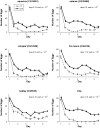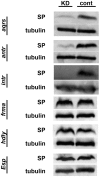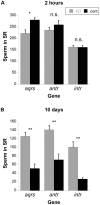Evolutionary rate covariation identifies new members of a protein network required for Drosophila melanogaster female post-mating responses
- PMID: 24453993
- PMCID: PMC3894160
- DOI: 10.1371/journal.pgen.1004108
Evolutionary rate covariation identifies new members of a protein network required for Drosophila melanogaster female post-mating responses
Abstract
Seminal fluid proteins transferred from males to females during copulation are required for full fertility and can exert dramatic effects on female physiology and behavior. In Drosophila melanogaster, the seminal protein sex peptide (SP) affects mated females by increasing egg production and decreasing receptivity to courtship. These behavioral changes persist for several days because SP binds to sperm that are stored in the female. SP is then gradually released, allowing it to interact with its female-expressed receptor. The binding of SP to sperm requires five additional seminal proteins, which act together in a network. Hundreds of uncharacterized male and female proteins have been identified in this species, but individually screening each protein for network function would present a logistical challenge. To prioritize the screening of these proteins for involvement in the SP network, we used a comparative genomic method to identify candidate proteins whose evolutionary rates across the Drosophila phylogeny co-vary with those of the SP network proteins. Subsequent functional testing of 18 co-varying candidates by RNA interference identified three male seminal proteins and three female reproductive tract proteins that are each required for the long-term persistence of SP responses in females. Molecular genetic analysis showed the three new male proteins are required for the transfer of other network proteins to females and for SP to become bound to sperm that are stored in mated females. The three female proteins, in contrast, act downstream of SP binding and sperm storage. These findings expand the number of seminal proteins required for SP's actions in the female and show that multiple female proteins are necessary for the SP response. Furthermore, our functional analyses demonstrate that evolutionary rate covariation is a valuable predictive tool for identifying candidate members of interacting protein networks.
Conflict of interest statement
The authors have declared that no competing interests exist.
Figures






Similar articles
-
The sex peptide of Drosophila melanogaster: female post-mating responses analyzed by using RNA interference.Proc Natl Acad Sci U S A. 2003 Aug 19;100(17):9923-8. doi: 10.1073/pnas.1631635100. Epub 2003 Jul 31. Proc Natl Acad Sci U S A. 2003. PMID: 12893873 Free PMC article.
-
The Female Post-Mating Response Requires Genes Expressed in the Secondary Cells of the Male Accessory Gland in Drosophila melanogaster.Genetics. 2016 Mar;202(3):1029-41. doi: 10.1534/genetics.115.181644. Epub 2016 Jan 8. Genetics. 2016. PMID: 26746709 Free PMC article.
-
Sex peptide is required for the efficient release of stored sperm in mated Drosophila females.Genetics. 2010 Oct;186(2):595-600. doi: 10.1534/genetics.110.119735. Epub 2010 Aug 2. Genetics. 2010. PMID: 20679516 Free PMC article.
-
[What the study of seminal fluid proteins in Drosophila tells us about the evolution of reproduction].Med Sci (Paris). 2014 Jun-Jul;30(6-7):651-7. doi: 10.1051/medsci/20143006015. Epub 2014 Jul 11. Med Sci (Paris). 2014. PMID: 25014456 Review. French.
-
Sex-peptides: seminal peptides of the Drosophila male.Cell Mol Life Sci. 2003 Aug;60(8):1689-704. doi: 10.1007/s00018-003-3052. Cell Mol Life Sci. 2003. PMID: 14504657 Free PMC article. Review.
Cited by
-
The Drosophila prage Gene, Required for Maternal Transcript Destabilization in Embryos, Encodes a Predicted RNA Exonuclease.G3 (Bethesda). 2016 Jun 1;6(6):1687-93. doi: 10.1534/g3.116.028415. G3 (Bethesda). 2016. PMID: 27172196 Free PMC article.
-
A predominant role of genotypic variation in both expression of sperm competition genes and paternity success in Drosophila melanogaster.Proc Biol Sci. 2023 Sep 27;290(2007):20231715. doi: 10.1098/rspb.2023.1715. Epub 2023 Sep 20. Proc Biol Sci. 2023. PMID: 37727083 Free PMC article.
-
Single-nucleus transcriptomes reveal evolutionary and functional properties of cell types in the Drosophila accessory gland.Genetics. 2022 Feb 4;220(2):iyab213. doi: 10.1093/genetics/iyab213. Genetics. 2022. PMID: 34849871 Free PMC article.
-
Evolution of DNMT2 in drosophilids: Evidence for positive and purifying selection and insights into new protein (pathways) interactions.Genet Mol Biol. 2018;41(1 suppl 1):215-234. doi: 10.1590/1678-4685-GMB-2017-0056. Epub 2018 Mar 26. Genet Mol Biol. 2018. PMID: 29668012 Free PMC article.
-
Filamin actin-binding and titin-binding fulfill distinct functions in Z-disc cohesion.PLoS Genet. 2017 Jul 21;13(7):e1006880. doi: 10.1371/journal.pgen.1006880. eCollection 2017 Jul. PLoS Genet. 2017. PMID: 28732005 Free PMC article.
References
-
- Poiani A (2006) Complexity of seminal fluid: a review. Behavioral Ecology and Sociobiology 60: 289–310.
-
- Chapman T, Davies SJ (2004) Functions and analysis of the seminal fluid proteins of male Drosophila melanogaster fruit flies. Peptides 25: 1477–1490. - PubMed
-
- Soller M, Bownes M, Kubli E (1997) Mating and sex peptide stimulate the accumulation of yolk in oocytes of Drosophila melanogaster . European Journal of Biochemistry 243: 732–738. - PubMed
Publication types
MeSH terms
Substances
Grants and funding
- R01 GM095793/GM/NIGMS NIH HHS/United States
- T32 GM007617/GM/NIGMS NIH HHS/United States
- F32GM084592/GM/NIGMS NIH HHS/United States
- F32GM097789/GM/NIGMS NIH HHS/United States
- F32 GM084592/GM/NIGMS NIH HHS/United States
- R01 HG009299/HG/NHGRI NIH HHS/United States
- R01HD038921/HD/NICHD NIH HHS/United States
- R01 GM084947/GM/NIGMS NIH HHS/United States
- F32 GM097789/GM/NIGMS NIH HHS/United States
- NIH/NIGMS R01-GM084947/PHS HHS/United States
- R01GM64313/GM/NIGMS NIH HHS/United States
- R01 HD038921/HD/NICHD NIH HHS/United States
LinkOut - more resources
Full Text Sources
Other Literature Sources
Molecular Biology Databases

